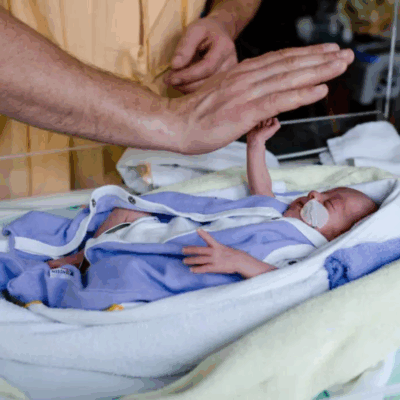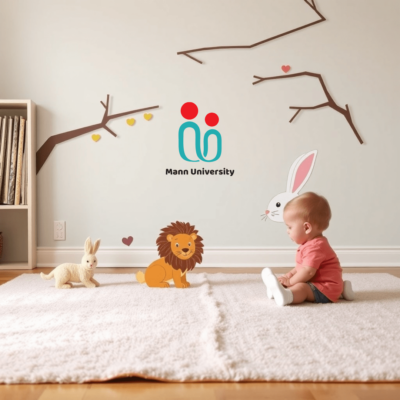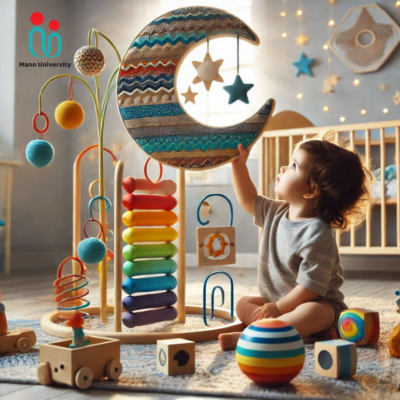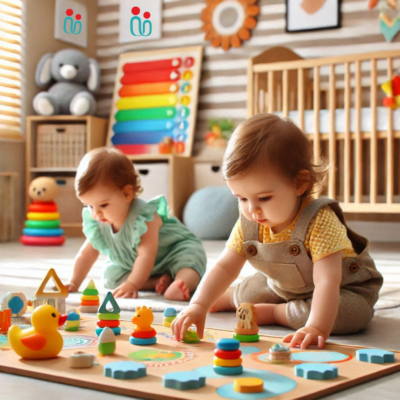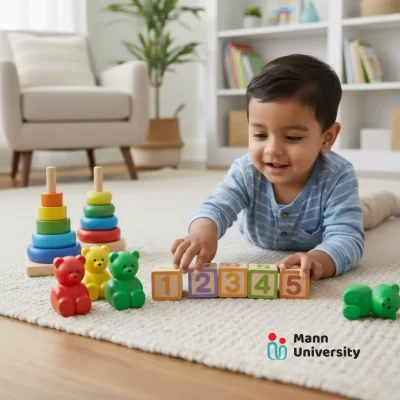Table of Contents
Toddler Biting, Hitting, and Pushing? Why It Happens & How to Stop It.
It’s a moment every parent of a toddler dreads: the sudden lunge, the sharp cry, and the realization that your sweet, cuddly child has just bitten, hit, or pushed another. Before you spiral into thoughts of raising a “playground bully,” take a deep breath. This behavior, while upsetting, is a normal part of toddler development. Understanding the “why” behind these actions is the first step to effectively guiding your little one toward more peaceful interactions. This behavior is a normal—though challenging—part of toddler development.
This guide is designed to be a clear, reassuring, and practical resource for parents navigating this challenging phase. We’ll break down the reasons for this aggressive behavior and provide simple, positive strategies to manage it.
Why is My Toddler Hitting and Biting others? The Root Causes
Your toddler isn’t being mean. Their aggressive actions are often clumsy attempts to communicate or cope with feelings they can’t yet manage.
🗣️ Limited Language Skills: Imagine feeling frustrated but not having the words to say, “That’s my toy!” or “You’re too close.” For a toddler, a push or a bite is a quick way to get a message across.
🌪️ Big Emotions, Little Control: Toddlers feel anger, excitement, and jealousy just as we do, but their ability to control these feelings is still developing. Lashing out is an impulsive reaction to an emotion they don’t understand.
🔬 Exploring Cause and Effect: Toddlers are little scientists. “What happens when I push this block?” isn’t so different from, “What happens when I push my friend?” They are learning about actions and reactions.
🦷 Teething and Oral Fixation: For younger toddlers, biting can relieve the pain of sore gums. It’s also a primary way they explore their world—by putting things in their mouths.
🙋 Seeking Attention: Attention—even negative attention—is a powerful reward. A toddler who feels ignored may learn that a hit or bite gets an immediate, focused response from you.
😴 Overload and Discomfort: Just like adults, toddlers have shorter fuses when they are tired, hungry, or overwhelmed by a noisy, crowded space. These states lower their already limited coping skills.
How to Stop Toddler Hitting and Biting: A Step-by-Step Plan
Your response is key. The goal is to be consistent, calm, and compassionate. Here’s how to handle it in the moment and what to do proactively.
Part 1: In the moment of impulse
Stay Calm & Intervene Immediately. Your calm presence models self-control. Gently but firmly separate the children.
Turn to the Hurt Child First. Offer comfort and check on the child who was hurt. This action shows your toddler that aggression is not an effective way to get your primary attention.
Acknowledge Your Toddler’s Feelings. Kneel down to their level. Use simple language to label their emotion. This helps them connect feelings to words.
Instead of: “Stop it! Don’t hit!”
Try This: “You look very angry that he took your car.”
State the Boundary Clearly & Calmly. Reiterate the house rule without shaming.
Instead of: “You’re being bad!”
Try This: “It’s okay to be angry, but it is not okay to hit. We use gentle hands.”
Remove & Reset. Briefly remove your child from the situation for a “cool-down” period. This is not a punishment but a chance to reset.
Try This: “Let’s go sit over here for a minute until we can use our gentle hands again.”
Part 2: Proactive Strategies for Prevention
Create a “Calm-Down Corner.” Designate a cozy, safe spot in your home with soft pillows, a favorite stuffed animal, or sensory items (like a glitter jar). Introduce it as a place to go to feel better, not as a punishment. Model it yourself when you’re frustrated!
Teach and Model Empathy. Talk about feelings all the time. When reading, ask, “How do you think the bunny feels?” Use everyday situations to build emotional vocabulary.
Provide Alternatives. Give your child the words to use. Practice saying, “My turn, please,” or “Stop, I don’t like that.” For biters, offer appropriate chew toys or crunchy snacks.
Read Books About Feelings. Stories are a powerful way to teach social skills. Some great options include:
“Hands Are Not for Hitting” by Martine Agassi
“Teeth Are Not for Biting” by Elizabeth Verdick
“The Feelings Book” by Todd Parr
Anticipate Triggers. If you know your toddler gets aggressive when tired, avoid playdates right before naptime. If sharing is a hot-button issue, talk about it before a friend arrives.
Praise the Positive. Catch them being good! When they share, wait their turn, or use words, give specific praise. “I love how you used your gentle hands with the baby!”
Common Mistakes to Avoid When Your Toddler Slaps
🛑 Never Hit or Bite Back. This reinforces the idea that aggression is how we solve problems. You must be the model for the behavior you want to see.
🛑 Avoid Shaming. Phrases like “You’re a bad boy” are harmful. Focus on the behavior (“Hitting is not okay”), not the child’s character.
🛑 Don’t Force an Apology. A forced “sorry” is meaningless to a toddler. Instead, encourage empathy. Have them help the other child by getting an ice pack or a favorite toy. True remorse comes with time and development.
Proactive Strategy: Create a “Calm-Down Corner”
Instead of a punitive “time-out,” consider creating a positive space designed to help your toddler manage their big emotions. A “Calm-Down Corner” isn’t a place for punishment, but rather a safe, cozy spot your child can go to when they feel overwhelmed. The goal is to teach them how to self-soothe.
How to Create Your Corner:
Choose a Cozy Spot: Find a quiet, low-traffic area of your home, like a corner of the playroom or living room. The key is that it feels safe and is not isolating.
Make it Comfortable: Start with a soft rug, a large pillow, or a small beanbag. Comfort is the main invitation.
Add Soothing Items: This is where you can tailor it to your child. Include a few comforting objects like:
A favorite stuffed animal or a soft blanket.
Sensory items like a sealed glitter jar (shake it and watch the glitter settle), a squishy stress ball, or soft modeling dough.
A few board books (see our recommendations below!).
Introduce it Positively: Show your child the corner when you are both calm. You can say, “This is our cozy corner. When you feel upset or angry, you can come here to relax with your special things.” Model it yourself! If you’re feeling frustrated, you might say, “Mommy is feeling a little frustrated, so I’m going to sit in the cozy corner and take three deep breaths.”
Using Books to Teach: Stories About Feelings and Actions
Reading books together is a powerful way to give your child the vocabulary for their feelings and to see situations from another’s point of view. It’s a gentle way to discuss these tough topics in a moment of connection.
Here are a few highly recommended books for toddlers:
“Hands Are Not for Hitting” by Martine Agassi: This simple board book is direct and effective. It shows all the wonderful things hands can do—wave, clap, help, and play—while clearly stating that they are not for hitting.
“Teeth Are Not for Biting” by Elizabeth Verdick: From the same series, this book is perfect for toddlers in the biting phase. It explains that teeth are for chewing and smiling, not for hurting friends.
“Calm-Down Time” by Elizabeth Verdick: This book gives toddlers simple, actionable strategies they can use when they feel upset, like getting a hug, finding a quiet place, or snuggling a blanket. It’s a perfect companion to your new Calm-Down Corner.
“The Feelings Book” by Todd Parr: With bright, simple illustrations, this book helps toddlers identify and name a wide range of emotions, from silly to sad to angry. It helps normalize the idea that everyone has lots of different feelings, and that’s okay.
A Note for You, the Parent: Managing Your Own Frustration
Let’s be honest: it is incredibly stressful and often embarrassing when your child lashes out. It can trigger your own big feelings of anger, frustration, or helplessness. Your ability to stay calm is your most powerful tool, but it’s not always easy. It’s okay to need a moment yourself.
Take a “Parent Pause”: If you feel your own anger rising, ensure your child is in a safe place and step back for a moment. Go to another room, take three deep, slow breaths, and let your shoulders drop. You are modeling the very same self-regulation you want to teach your child.
Use a Simple Mantra: In your head, repeat a simple, calming phrase like, “This is a phase, not forever,” or “He is having a hard time, not giving me a hard time.” This can help shift your perspective in a heated moment.
Don’t Aim for Perfection: You won’t handle every situation perfectly, and that’s okay. There will be times you react with frustration. When that happens, be kind to yourself. If necessary, you can even model a healthy apology later: “I’m sorry I raised my voice earlier. I was feeling very frustrated.”
From Toddlerhood to Friendship: The Bigger Picture
As you navigate these challenging moments, try to hold onto the bigger picture. Every time you stop your child from hitting someone else, label a feeling, or model a gentle touch, you are not just managing a behavior—you are building the foundation for your child’s emotional intelligence.
These difficult interactions are their first, clumsy lessons in empathy, boundaries, and self-control. By guiding them with consistency and compassion, you are teaching them that all feelings are okay, but not all actions are. You are showing them how to resolve conflict peacefully and how to express their needs with words.
This phase is intense, but it is temporary. It will be replaced by new words, greater understanding, and the blossoming of true friendship skills. You are your child’s first and most important teacher in this journey. Stay patient, stay consistent, and know that the work you are doing now is shaping the kind, capable person they are becoming.
Resource Pack: Positive Language & Skill-Building Activities
This pack moves from reacting to aggression to proactively building the skills your toddler needs to manage their emotions and body.
Part 1: Positive Language Swaps for Parents
The words we use matter. They can either escalate a situation or become a teaching moment. Here are some simple swaps to try when you’re feeling stressed.
Instead of Saying This… | Try Saying This… | Why It Works |
“Stop it! Don’t hit!” | “I won’t let you hit. Hitting hurts.” | Sets a firm, calm boundary without adding anger. Shows you are the protector. |
“You’re being a bad boy/girl.” | “You are feeling very angry right now.” | Separates the child from the behavior. It validates their feeling while opening the door to talk about it. |
“Say you’re sorry!” | “Let’s help our friend feel better. Should we get them the ice pack or their teddy?” | Teaches empathy and repair instead of forcing a meaningless apology. |
“There’s no reason to cry.” | “You seem really sad that playtime is over.” | Acknowledges their feeling as real and important, helping them feel understood. |
“Calm down!” | “Let’s take a big dragon breath together. Whooosh.” | Gives a concrete, actionable tool for calming down instead of an abstract command. |
Part 2: Simple Activities to Teach Self-Control & Empathy
Incorporate these simple games into your playtime to build crucial social-emotional skills in a fun, low-pressure way.
1. Activity: The “Feeling Faces” Game
What You Need: Paper plates and a marker, or just your own faces.
How to Play: Draw simple happy, sad, angry, and surprised faces on paper plates. Hold one up and say, “This is the happy face! Let’s make a happy face.” Make the face with your toddler. Then, talk about it: “What makes you feel happy? Playing with blocks makes me feel happy.” Do the same for sad and angry faces, providing simple, safe examples.
What It Teaches: Emotional literacy. It gives your child a vocabulary for their feelings, which is the first step to managing them.
2. Activity: “Drum Beats” for Big Energy
What You Need: A pillow, a couch cushion, or even just your toddler’s feet.
How to Play: When you see your child getting frustrated or having a burst of physical energy that might turn into a hit, redirect it. Say, “You have so much energy! Let’s get it out. Let’s drum on this pillow!” and start drumming with your hands. Or, “Let’s stomp our feet like a dinosaur! Stomp, stomp, stomp!”
What It Teaches: A physical outlet. It gives them a safe and acceptable way to release frustration and physical energy, teaching them that the feeling isn’t bad, but they need a safe way to express it.
3. Activity: “Gentle Hands, Helping Hands”
What You Need: A favorite stuffed animal or a doll.
How to Play: During a calm moment, sit with your child and their teddy bear. Say, “Let’s practice being gentle with Teddy.” Use a soft voice and gently stroke the bear’s fur, saying, “Gentle, gentle hands.” Then, create a scenario: “Oh no, Teddy fell down! Let’s use our helping hands to help him up.”
What It Teaches: Positive physical touch. It creates muscle memory for what “gentle” feels like and connects their hands with the positive concept of “helping.”
A Proactive Parent’s Daily Checklist for Fostering Gentle Behavior
This is a simple checklist to help integrate the proactive strategies into your daily routine, making them a natural part of your family’s life.
Daily Actions
[ ] Narrate Feelings (Yours and Theirs): Spend 5 minutes verbalizing emotions.
“You seem frustrated that the block tower fell.”
“Mommy is feeling happy because the sun is shining.”
[ ] “Catch Them Being Gentle”: Find at least one instance of gentle behavior and praise it specifically.
“I love how you used gentle hands when you petted the cat.”
[ ] One-on-One Connection: Dedicate 10 minutes of screen-free, uninterrupted playtime. This fills their “attention cup” positively.
[ ] Offer Appropriate Outlets: Before energy gets high, offer a safe way to release it.
“Let’s have a quick dance party!” or “Let’s stomp like elephants!”
Weekly Actions
[ ] Read a Book About Feelings: Choose one or two books from your collection that focus on emotions, sharing, or kindness to read together.
[ ] Tidy the “Calm-Down Corner”: Spend a few minutes with your toddler making sure their cozy corner is inviting and stocked with their favorite soothing items.
[ ] Pre-Game a Social Situation: Before a playdate or family gathering, briefly talk about what to expect.
“Auntie is coming over today. Remember, we share our toys so everyone can have fun.”
Toddler Hitting & Biting: Your 2-Minute Cheat Sheet
IN THE MOMENT:
Stay Calm & Intervene: Gently but firmly stop the action.
Simple, Firm Words: Say, “No hitting. Hitting hurts.”
Comfort the Hurt Child First: Turn your primary attention to the person who was hurt. This shows the action doesn’t get your toddler positive attention.
Acknowledge Feelings, State the Rule: Say, “I see you are angry, but we do not hit. We use gentle hands.”
Remove & Redirect: Guide your child to a “Calm-Down Corner” or a quiet activity to reset.
WHAT TO AVOID:
Don’t Hit/Bite Back: It teaches that aggression is okay.
Don’t Shame: Avoid saying “You are bad.” Focus on the behavior.
Don’t Force “Sorry”: Encourage empathy by helping the other child instead.
PROACTIVE WINS:
Catch them being gentle and praise them for it.
Read books about feelings and gentle hands.
Anticipate triggers like hunger and tiredness.
When to Seek Professional Help
While this is a normal phase, consider speaking with a pediatrician or child development expert if:
The behavior is getting worse or more frequent, despite your efforts.
Your child seems unusually angry or unhappy most of the time.
The aggression is causing significant problems at daycare or preschool.
Your child is harming themselves or trying to seriously injure others.
You are feeling overwhelmed and struggling to cope.
The Takeaway for Parents
Navigating toddlerhood is a journey of patience and teaching. Remember, behind every bite, hit, or push is a child who is struggling to communicate. By responding with calm, firm, and compassionate guidance, you are giving your child the tools they need to grow into a kind and emotionally aware person. This phase will pass, and your consistent support is what will help them get there.
Frequently Asked Questions (FAQ)
How long does this phase last?
It typically peaks between ages one and two and fades as language and self-control improve, usually by age three or four. Your consistency helps them move through it faster.
What if my toddler hits or bites me?
The response is the same. Calmly stop the behavior, say, “No hitting. Hitting me hurts,” and put them down. Avoid a big emotional reaction.
Is it my fault my toddler is aggressive?
Absolutely not. This is a common developmental stage and not a reflection on your parenting. Your job is to guide and teach, not to be perfect.
Should I use a "time-out"?
Traditional punitive time-outs are less effective for toddlers. A “time-in” or a “cool-down” in their special corner with you is better. It shifts the focus from punishment to connection and regulation.






